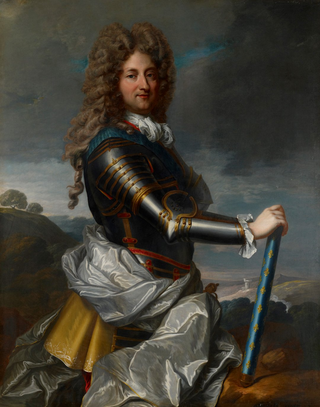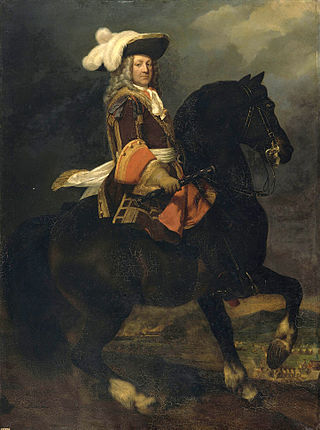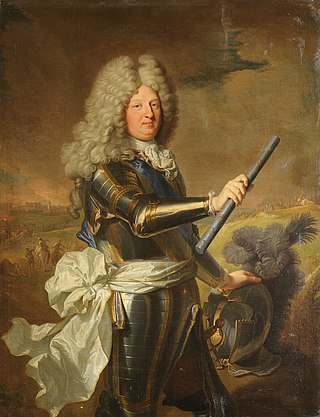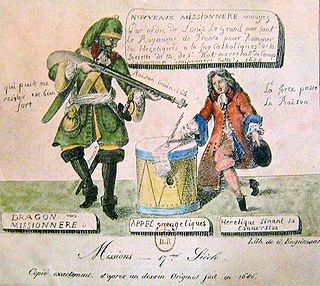| |||||
| Decades: | |||||
|---|---|---|---|---|---|
| See also: | Other events of 1700 History of France • Timeline • Years | ||||
Events from the year 1700 in France
| |||||
| Decades: | |||||
|---|---|---|---|---|---|
| See also: | Other events of 1700 History of France • Timeline • Years | ||||
Events from the year 1700 in France


The House of Bourbon is a European dynasty of French origin, a branch of the Capetian dynasty, the royal House of France. Bourbon kings first ruled France and Navarre in the 16th century. By the 18th century, members of the Spanish Bourbon dynasty held thrones in Spain, Naples, Sicily, and Parma. Spain and Luxembourg have monarchs of the House of Bourbon.

Philippe II, Duke of Orléans, was a French prince, soldier, and statesman who served as Regent of the Kingdom of France from 1715 to 1723. He is referred to in French as le Régent. He was the son of Monsieur Philippe I, Duke of Orleans, and Madame Elisabeth Charlotte, Duchess of Orleans. Born at his father's palace at Saint-Cloud, he was known from birth by the title of Duke of Chartres.

Françoise-Athénaïs de Rochechouart de Mortemart, Marquise of Montespan was the most celebrated maîtresse-en-titre of King Louis XIV, by whom she had seven children.

Louis Alphonse de Bourbon is the head of the House of Bourbon. Members of the family formerly ruled France and other countries. According to the Legitimists, Louis Alphonse is considered the pretender to the defunct throne of France as Louis XX. With the death of his father, he has been using the title of Duke of Anjou since 1989.

Louis, Duke of Orléans was a member of the House of Bourbon, and as such was a prince du sang. At his father's death, he became the First Prince of the Blood and Duke of Orléans. Known as Louis le Pieux and also as Louis le Génovéfain, Louis was a pious, charitable and cultured prince, who took very little part in the politics of the time.

The Régence was the period in French history between 1715 and 1723 when King Louis XV was considered a minor and the country was instead governed by Philippe d'Orléans as prince regent.

Anne Louise Bénédicte de Bourbon was the daughter of Henri Jules de Bourbon, Prince of Condé, and Anne Henriette of Bavaria. As a member of the reigning House of Bourbon, she was a princesse du sang. Forced to marry the Duke of Maine, legitimised son of Louis XIV and Madame de Montespan, she revelled in politics and the arts, and held a popular salon at the Hôtel du Maine as well as at the Château de Sceaux.

Louis Joseph de Bourbon, Duke of Vendôme, often simply called Vendôme was a French general and Marshal of France. One of the great generals of his era, he was one of Louis XIV's most successful commanders in the War of the Grand Alliance and War of the Spanish Succession.

Louis, Dauphin of France, commonly known as Grand Dauphin, was the eldest son and heir apparent of King Louis XIV and his spouse, Maria Theresa of Spain. He became known as the Grand Dauphin after the birth of his own son, Louis, Duke of Burgundy, the Petit Dauphin. He and his son died before his father and thus never became king. Instead, his grandson became King Louis XV at the death of Louis XIV, and his second son inherited the Spanish throne as Philip V through his grandmother.

Louise Henriette de Bourbon, Mademoiselle de Conti at birth, was a French princess, who, by marriage, became Duchess of Chartres (1743–1752), then Duchess of Orléans (1752–1759) upon the death of her father-in-law. On 4 February 1752, her husband became the head of the House of Orléans, and the First Prince of the Blood, the most important personage after the immediate members of the royal family.

Marie Anne de Bourbon, Légitimée de France, born Marie Anne de La Blaume Le Blanc, by her marriage Princess of Conti then Princess Dowager of Conti, suo jureDuchess of La Vallière and of Vaujours was a French noblewoman as the eldest legitimised daughter of Louis XIV, King of France, born from his mistress Louise de La Vallière, and the king's favourite daughter. She married Louis Armand I, Prince of Conti in 1680 and was widowed in 1685. She never married again and had no issue. Upon her mother's death, she became the suo jure Duchess of La Vallière and of Vaujours.

Carlo Bartolomeo Rastrelli was an Italian sculptor and architect. Born in Italy, he moved in 1716 to Russia, where he worked until his death. His most famous works include the Monument to Peter I and a wax figure and several busts of Peter the Great. His son Francesco Bartolomeo Rastrelli became a prominent architect in Russia.
Events from the year 1714 in France
Events from the year 1703 in France
Events from the year 1711 in France
Events from the year 1717 in France
Events from the year 1705 in France
Events from the year 1652 in France

Events from the year 1681 in France
Events from the year 1639 in France